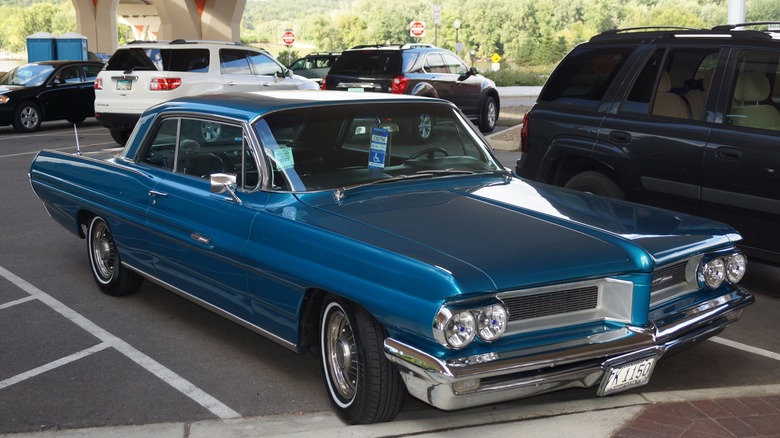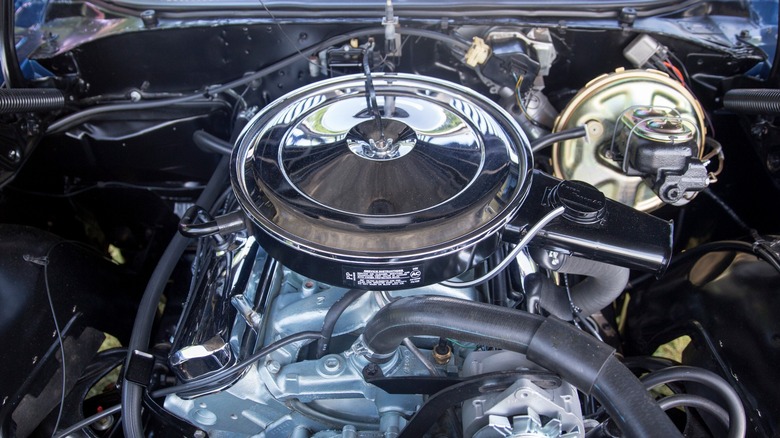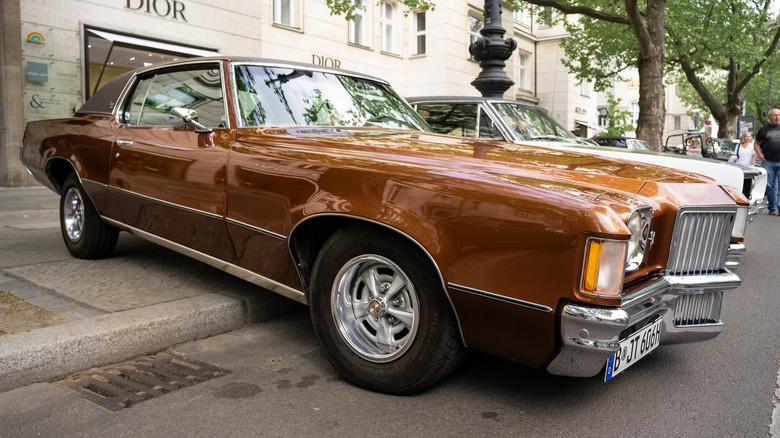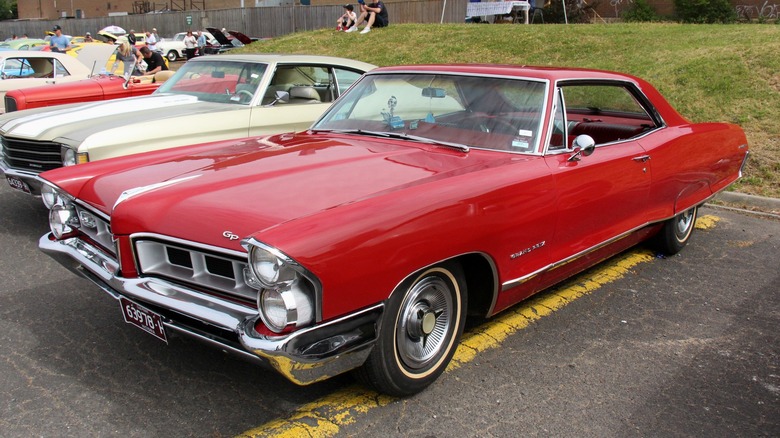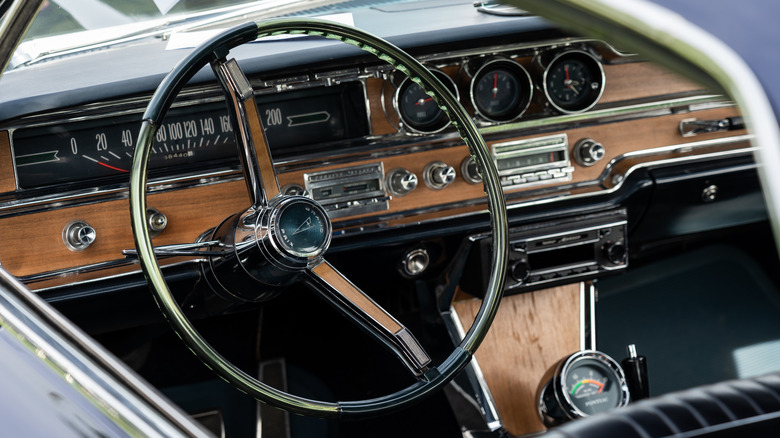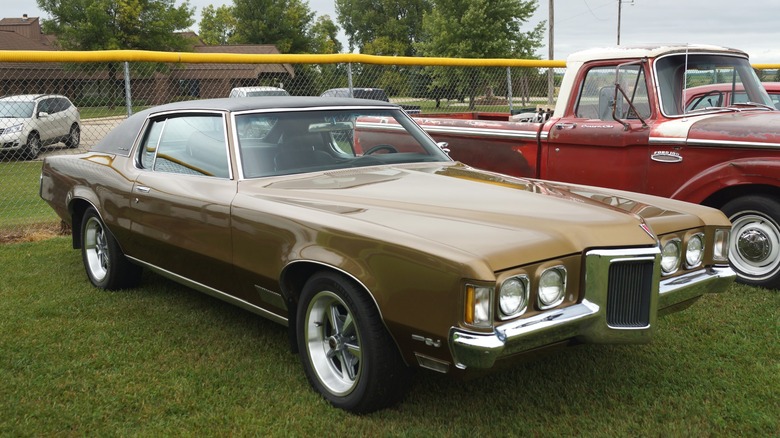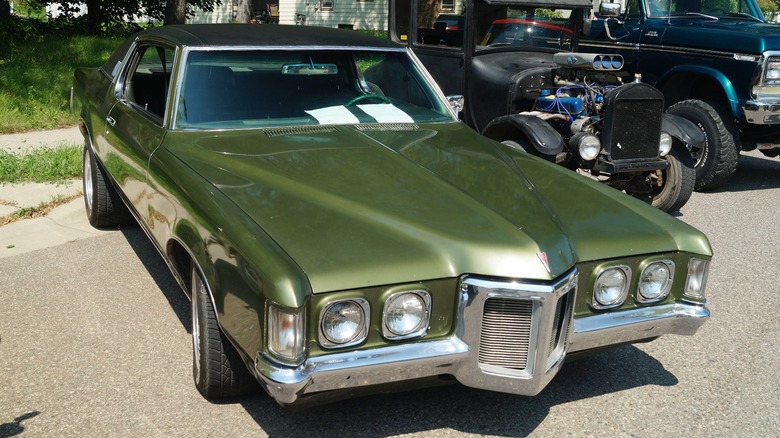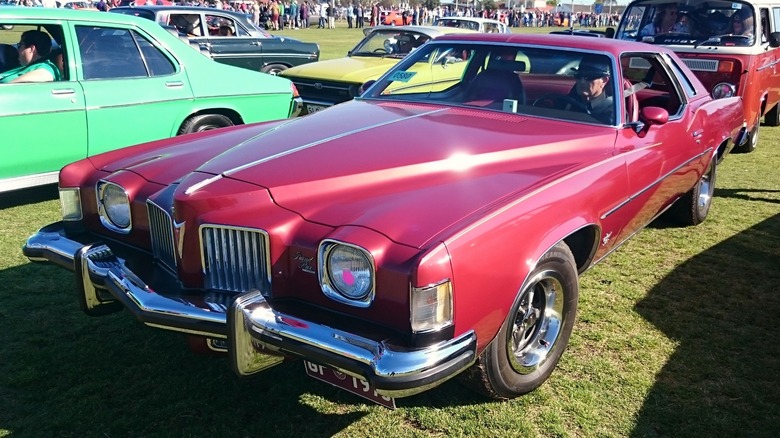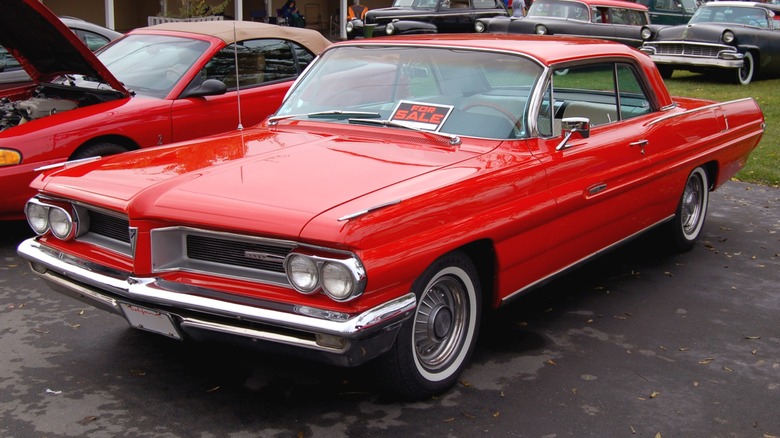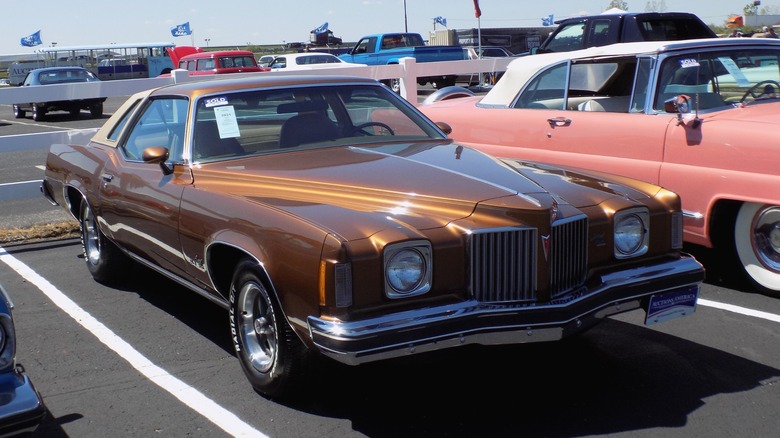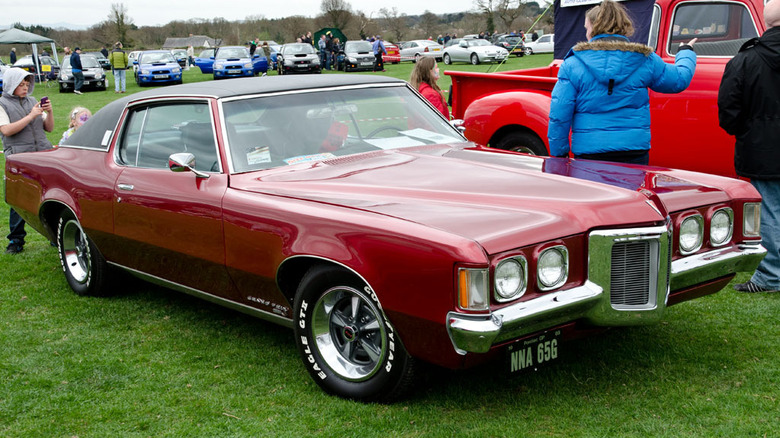10 Reasons An Old School Pontiac Grand Prix Is Still Worth Buying Today
When you think of 1960s and 1970s American muscle, your mind likely drifts to all the fast V8-powered classics of those decades, whether it's Chrysler's 426 Hemi-powered offerings like the late-1960s Plymouth Road Runner and Dodge Charger or GM cars like the Chevrolet Corvette 427. However, old-school American cars weren't all about raw performance. Vehicles like the classic 1950s Ford Thunderbirds charted a different path, one focused on style and luxury above all — and establishing the concept of the personal luxury car along the way.
The Thunderbird spawned decades' worth of imitators, and one of the most notable was Pontiac's Grand Prix. Debuting in 1962 as a full-sized, luxury-focused vehicle, the Grand Prix survived in the Pontiac lineup until it flopped in 2009, transitioning from old-school rear-wheel-drive V8 power to front-wheel drive in 1988. While the later front-wheel-drive Grand Prix models weren't necessarily bad, it shouldn't come as a surprise that it's the earlier V8 years that are the ones to go for — the first three generations, especially, all of which only came with classic Pontiac V8 engines.
Of course, the Grand Prix isn't the only old-school American car available on the used market, personal luxury or otherwise. We think there are quite a few great reasons that you may want to get a Grand Prix, including their great engines and amazing design. There are no guarantees whether any of these reasons will convince your partner, but there's no harm in trying, right?
[Image by Greg Gjerdingen via Wikimedia Commons | Cropped and scaled | CC BY 2.0]
Bonafide V8 power
One of the most compelling reasons to buy any old-school American car is what's under the hood, and the Grand Prix is no exception here. The first three generations of the Grand Prix, from its debut in 1962 until the introduction of the fourth generation in 1978, all had Pontiac V8s under the hood.
Pontiac launched the Grand Prix primarily as a luxury car, so the standard V8s weren't necessarily the most powerful examples ever. Even the standard 389-CI Trophy V8 in the first-generation Grand Prix made 303 gross horsepower and 425 lb-ft of torque — comparable to some of the best Mopar engines ever. You could also hunt down one equipped with the Trophy V8A, which cranked numbers up to 348 horsepower and 430 lb-ft when equipped with the Tri-Power triple-carb setup. Pontiac also offered the 421 Super Duty V8 with 405 horsepower for the first year, although you're not likely going to find one on the used market, seeing as how only 16 examples left the factory that year.
Power peaked in 1970 with the second-generation Grand Prix. The standard Grand Prix had a 400-CI V8 that produced 350 horsepower, while the higher-spec Grand Prix SJ took things a step further with 370 horsepower from its 455-CI V8, one of the best engines Pontiac ever used. Sadly, tightening emissions regulations and the 1973 oil embargo meant that the Grand Prix would never hit the same heights.
[Image by Mr.choppers via Wikimedia Commons | Cropped and scaled | CC BY-SA 3.0]
Decent handling
The early Grand Prix models had good straight-line speed, but let's face it: most of us don't live our lives a quarter mile at a time. The daily driver experience is just as important when buying a classic car, and the Grand Prix has you covered.
Befitting the nameplate's luxury and grand tourer direction, Pontiac specced a soft suspension setup for the Grand Prix from the outset. While this perhaps didn't quite suit some of the higher-powered engine options the company also offered, the floaty suspension has its admirers, even in the harsher light of modern-day expectations — just don't expect to tear up the autocross with a Grand Prix, and you'll be fine. Those who prefer a firmer ride will, however, be pleased to know that you can try to track down a Grand Prix with the optional heavy-duty suspension upgrade (or, more realistically, install a coilover kit).
The slightly downsized second-generation Grand Prix was even better, at least judging by contemporary reviews. Magazines hailed the 1969 Grand Prix as a good grand tourer, with good handling — even on a road course — and solid suspension behavior. The SJ handling package elevated the Grand Prix even further, earning it Car Life's Best Personal Car award of 1969. Realistically, any half-decent modern car will likely run rings around it, but the Grand Prix is great for what it is.
A piece of muscle car history
The legendary Pontiac GTO may be the car that most petrolheads consider the first bonafide muscle car ever — or, at least, the car that properly kickstarted the muscle car era we all know and love when it debuted in 1964 — but it wasn't Pontiac's first stab at chucking a burly, high-powered V8 into a full-sized sedan body. The GTO debuted in 1964, but the first-generation Grand Prix preceded it by two years, with the nameplate's first year coming in 1962.
To be clear, though, Pontiac didn't launch the Grand Prix as a tire-shredding performance monster. The first-generation Grand Prix had a nearly 4,000-pound curb weight, meaning the standard 303-horsepower V8 wasn't perhaps as peppy as it would have been in a lighter car. It still performed decently, but things only got serious with one of the higher-powered V8s under the hood. The ultra-limited 421 Super Duty-equipped Grand Prix, for example, ran the quarter mile in 14.3 seconds at 103 mph — not bad at all for 1962.
No, it wasn't quite as fast as the 3,500-pound GTO, which ran a 13.1-second quarter mile time in Car and Driver's tests. However, the Grand Prix is just as big a part of muscle car history as the GTO in our books, and you're buying into a lot of heritage if you get one — no matter whether it's a genuine pre-GTO example or one of the later models.
[Image by Cars Down Under via Flickr | Cropped and scaled | CC BY 2.0]
Old-school luxury
Don't get the wrong idea: you're not getting Lexus or BMW levels of luxury if you buy an old-school Pontiac Grand Prix. However, if the idea of a minimalistic muscle car interior doesn't appeal, then the Grand Prix just might be the old-school V8 car for you. At least, if you're not quite willing to go down the pure land yacht route.
The first-generation Grand Prix sported interior amenities such as a fully carpeted interior, bucket seats covered in leather-affect Morrokide, a rear armrest with a built-in speaker, and a cushioned instrument panel, all helping the nameplate live up to Pontiac's luxury ambitions. Pontiac kept pushing the Grand Prix further into mainstream territory through the rest of the decade, though, with the 1965 Grand Prix offering a bench seat option and coming ever closer to land-yacht territory.
Pontiac shook things up for 1969, introducing the name plate's best body style (which we'll discuss later) and a fresh new interior. The second-generation interior had a wrap-around cockpit with bucket seats, all swathed in a combination of vinyl and Morrokide — with leather also available. Pile carpets, wood-grain inlays, and taffeta headlining also came as standard. Both first and second-generation interiors are great, albeit in different ways. Having a nice interior to sit in might help compensate for some of the classic car headaches you may have to endure.
Inimitable style
The 1969 Grand Prix was something of a revolution for the nameplate. For one, the car was now a mid-sized car with a shorter 118-inch wheelbase (compared to the 121 inches of the previous model), which reflected shifting buyer tastes. The shorter wheelbase was nothing compared to the new sheet metal, which nailed the long hood and short rear deck design language perfectly, combining it with coke-bottle styling and an enjoyably exaggerated front radiator beak, even by Pontiac standards.
The new Grand Prix wasn't just about the big styling gestures, as great as they were. The new-look luxury-muscle car also had some excellent minor details that helped elevate it beyond just another slab of sheet metal out of Detroit. For example, take the recessed door handles and hidden radio antenna, both of which gave the Grand Prix quite a sleek look. The 1969 Grand Prix also had hidden windscreen wipers for an even more stylish presentation, although this feature had debuted the year before.
The first-generation Grand Prix is also a great-looking car in its full-sized, 1960s way, and we wouldn't turn one down. If you ask us, though, the second-generation Grand Prix has it beat.
[Image by Greg Gjerdingen via Wikimedia Commons | Cropped and scaled | CC BY 2.0]
The best body styles were quite long-lived
If you, like us, firmly believe that the Ben Harrison-designed second-generation Pontiac Grand Prix is the best a nameplate has ever looked, then we have good news: you have options. There are two generations to choose from if you like that particular look, giving you plenty of choices when trying to track down the right Grand Prix.
Pontiac knew it was onto a good thing with the 1969 Grand Prix's design, avoiding any drastic changes through the second generation's run. It arguably got better, too, with the 1971 model getting an even more prominent front grille and sculpted rear end. While it was undoubtedly a bad time for all involved, the autumn 1970 UAW strike meant that we got another year of this peak Grand Prix body style, with the 1972 Grand Prix looking almost identical to the previous year's model.
Pontiac cleverly used many of the second generation's styling cues when it debuted the third-generation Grand Prix in 1973. No, it's not the same design, but it's still a handsome car that retains the second generation's DNA — even if, as some commentators have opined, the car lost some of its uniqueness in the process. Pontiac facelifted the third-gen Grand Prix in 1976, introducing rectangular headlights and a new grille. The final model year for the third generation was 1977, making for an eight-year run for these two similar body styles.
[Image by Greg Gjerdingen via Wikimedia Commons | Cropped and scaled | CC BY 2.0]
The price is right
Old-school American cars can get very expensive, and we're not even talking about the the most expensive muscle cars of all time: even the Grand Prix's 1960s stablemate, the first-generation Pontiac GTO, generally sells for around $60,000, according to market databases like Classic.com. Sure, that's peanuts compared to the rarest Pontiac muscle cars, some of which can sell for close to $1 million, but it's still a lot of money for the average Joe.
If luxury and style are higher on your list than raw tire-shredding power, you'll be happy to know that you won't need to spend a fortune to get a good-condition Grand Prix in your life. Decent examples of the relatively pricey second-generation Grand Prix generally sell in the $30,000 ballpark, with some still-decent examples even selling for less than $20,000. That's not too surprising, considering more than 320,000 second-gen Grand Prix left the factory.
The full-sized first-generation Grand Prix also seems to be a $30,000 car, at least based on historical sales averages. Recent listings as of October 2024 have the first-gen model sitting closer to $40,000, but there's no guarantee that the cars will sell at that price. The bargain is arguably the third-generation Grand Prix, which has an average selling price of under $20,000, with many examples selling this year for less than half that. You may have to live with weaker V8s, but you're certainly getting a great-looking car for a great price.
[Image by GTHO via Wikimedia Commons | Cropped and scaled | CC BY-SA 4.0]
You'll probably get your money back (if not more)
Predicting the future can be tough, so don't take this as financial advice, but if we're going by Classic.com's average sales prices over the past few years, old-school Grand Prix values have stabilized or even slightly increased. For a prospective Grand Prix owner, this means you're likely not going to be too severely out of pocket if — or when — it comes time to sell yours in the future.
You might have to take a hit on some of the more mundane replacement parts you'll possibly have to install to keep the car going, but it looks like you should be able to at least get the money you paid for the car itself back without too many problems, at least going by historical price trends. The second and third-generation Grands Prix have appreciated slightly over the years, so you may even be able to make a profit if you buy a decent example at the right price.
Even the used car price crash of 2023 doesn't seem to have affected the Grand Prix too severely, with no drastic dips in the average sale prices across that year. Does this mean that you should definitely invest? Not necessarily. There are better cars for that. Still, you should be able to own and enjoy a Grand Prix without worrying too much about your bottom line.
[Image by Dave Parker via Wikimedia Commons | Cropped and scaled | CC BY 2.0]
Good parts availability
One big worry you may have before buying an old Grand Prix is getting any necessary parts to get — and keep — it running. After all, a 1963 Grand Prix isn't quite the same as a 2024 Honda Civic, at least as far as manufacturer parts support goes.
Thankfully, most of the important parts don't seem too hard to obtain. Online retailers such as eBay have listings for all manner of parts, from exterior trim like the wiper blades to all-important components such as front-end rebuild kits and oil pumps. If you're not keen on eBay, parts suppliers like Summit Racing also carry parts for Grands Prix, and the site even lets you filter by model year so you know you'll get something that works. However, there's a bit of a catch.
While the mechanical parts — and some trim — are relatively easy to acquire, the situation is quite different when it comes to the body. We haven't spotted many listings for replacement panels, and restoration reports also mention the need for patch panels and fabrication. While you'll probably be able to get almost any Grand Prix model into good running order without too much trouble, you'll still want to find one with good sheet metal — or be willing to spend time hunting in junkyards and on online marketplaces like Facebook Marketplace.
[Image by Greg Gjerdingen via Wikimedia Commons | Cropped and scaled | CC BY 2.0]
It's a DeLorean (in a way)
This point is more for the history and heritage buffs out there, but we imagine anyone considering a classic American car will have a bit of that in them. Buying an old-school first- or second-generation Pontiac Grand Prix isn't just about buying an old car; it's also about getting a bit of that John DeLorean aura in your life — yes, the very same DeLorean behind the iconic gullwing-doored DeLorean DMC-12.
DeLorean joined Pontiac in 1956 and had a hand in many of its iconic cars, including the Pontiac GTO, which he developed, engineered, and promoted. However, while the GTO will likely forever be remembered as his crowning achievement, DeLorean was more than a one-hit wonder. He, alongside designer Ben Harrison, was also behind the 1969 Grand Prix, moving it to a smaller mid-sized platform to suit buyers' ever-changing tastes. It was a stroke of genius: Pontiac sold 112,486 units in 1969 alone, and DeLorean had another successful car under his belt.
The 1969 Grand Prix would also be DeLorean's last contribution to the Pontiac brand. GM offered him the Chevrolet gig that same year, which he accepted. DeLorean eventually helped launch Chevrolet's stylish and underappreciated Chevrolet Monte Carlo, essentially its take on the Grand Prix. Buy a second-gen Grand Prix and tell everyone you drive a DeLorean — it's technically true, right?
[Image by Steve Glover via Flickr | Cropped and scaled | CC BY 2.0]
